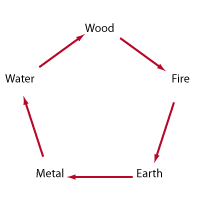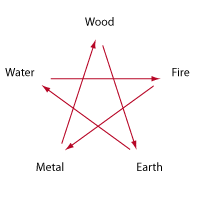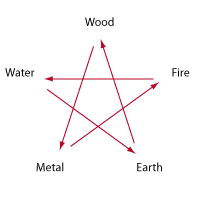Maybe the Taoistic theory of the Five Elements can be seen as a further, more refined step to understand and categorize or analyse the Yin-Yang philosophy.
The Theory of the Five Elements describes the interaction and relation between Yin and Yang, between phenomena.
Taoism theories use symbols to describe phenomens of reality, hence each of the Five Elements represent an aspect of a dynamic process, a processe's phases of change. In this sense, Wood is not only the actual wood of a tree as defined by the substance, but describes the character, the dynamic state, the elemental force of the element.
Wood - rising, development (of an action), impulse, expansion, decampment
Fire - embodiement, definition, action, dynamic phase, design
Earth - alteration, transformation, transmutation, change, convertation
Metal - sinking, contraction, declining
Water - contemplation, calmness, (re-)consideration, observation, reflection
The basic substances of the material world according to the ‘Theory of the Five Elements’ are Wood, Fire, Earth, Metal and Water.
All material things are made of a single or a combination of the Five Elements, since these are the fundamental components.
All Five Elements are equally important and should form a balance, while being in constant move and cyclical change (phases).
Each phase’s peak already consists of its decline, then forwarding the prior received/ gathered (chi) energy from one element to the following element.
The ‘generating’ or ‘controlling’ element is building up the energy to its own peak, before the decline starts again.
This interactive process is being constantly repeated, hence forming a never ending, though balanced circle.
Not only time changes things, but since everything changes within itself anyway, the ‘Theory of the Five Element’ is simply an observation of natural, creative changes; and it is the natural world confirming that all forces and energies in nature can be in constant smooth and harmonious transition from one phase to another - just as one season 'becomes' the next.
Each existing material, combined of parts of the Five Elements, shows a pre- domination of one of the Five Elements and is assigned an abstract generalization, hence can be classified accordingly.
Associations were later made with the human body and its organs and senses, colours, biota, foods etc. ("The East generates wind, wind generates wood, wood generates sour, sour generates liver, liver generates tendons....".)
The Generating, Inter-promoting or Enhancing Cycle (生; shēng)

The Generating Cycle: one element (serving as parent) enriches, nourishes, strengthens, promotes growth and development of the following element (serving as child).
Generating: Wood feeds Fire - Fire creates Earth (ash) - Earth bears Metal - Metal (trace elements) collects, enrich Water - Water nourishes Wood
Interpretation: (supporting, helping)
- Wood is the supporting element of Fire. Fire can release the power of Wood.
- Fire is the supporting element of Earth. Earth can release the power of Fire.
- Earth is the supporting element of Metal. Metal can release the power of Earth.
- Metal is the supporting element of Water. Water can release the power of Metal.
- Water is the supporting element of Wood. Wood can release the power of Water.
The Controlling , Destructing or Inter-restraining (剋,克; kè) and the Weakening (侮, wǔ) Cycle
The controling (destructing) cycle (剋,克; kè)

Grandparent - Grandchild relationship: the controlling cycle provides for a check and balance system among all of the elements.
The controlling or destructing cycle: one element surpresses, controls, dominates, overcomes, weakens another element, preventing it from establishing its power.
A metalic knife can cut wood into pieces, hence controlling the shape of wood (though not destroying the chi energy)
Interpretation:
Wood can break the ground (Earth).
Earth can soak up Water, blocking its flow.
Water can control Fire.
Fire can melt Metal.
Metal can chop Wood.
The overacting cycle cheng
The overacting (overwhelming) cycle (cheng) is an inbalance within the ke cycle, while following the ke cycle's direction. The grandparent element provides too much control over the grandchild and weakens the element. Each element excessivley restrains another beyond the normal extend. This usually occures when an element is in excess:
- too much Wood overacts Fire
- too much Fire overacts Earth
- too much Earth overacts Metal
- too much Metal overacts Water
- too much Water overacts Wood
The weakening (insulting) cycle (侮, wǔ)

The weakening (insulting) cycle (侮, wǔ): Grandchild insults or returnes the controlling force generated by the Grandparent.
The weakening cycle is an imbalance within the controlling cycle, where that, what is destroyed, enjures the destroyer. The imbalance follows along the opposite route of the ke cycle, each element can insult the one that normally restrains it. The reverse of the ke cycle normally occures when the balance is broken, especially when one element is insufficient.
Interpretation: Weakening cycle: Earth can bury Wood. Water washes away Earth. Fire enjures = evaporates Water.
- too much Wood insults Metal
- too much Metal insults Fire
- too much Fire insults Water
- too much Water insults Earth
- too much Earth insults Wood
Interrelation of the cycles
Sheng and Ke cycle:
The Sheng and Ke cycle form a feedback system, which keeps the system/ body/ universe in balance. The Sheng and Ke cycle ensure that each element is connected with the other four elements.
Wood restrains Earth, but at the same time, the Earth promotes Metal, which than restrains the Wood. In this instance, Metal makes sure, that Wood does not restrain Earth too excessivley.
Ke and Wu cycle:
The Controling- Weakening cycle or Ke and Wu cycle represents a conflicting (fighting) aspect.
- Wood can break the ground (Earth), but Earth can bury Wood, too.
- Earth can absorb Water, but Water can cover the land (Earth).
- Water can extinguish Fire, but Fire might evaporate Water.
- Fire can melt Metal, but Metal might not melt before Fire is extinguished.
- Metal can cut Wood, but Metal might become dull before breaking Wood.
Wu and Cheng cycle:
If any of the elements are over abundant, they can disrupt the balance of the circle.
CHARACTERISTICS AND ASSOCIATIONS OF THE ELEMENTS
WOOD (Chinese: 木, pinyin: mù)
Wood is the most human of the elements. It is the element of spring; the creative urge to achieve - which can turn to anger when frustrated. It is associated with the capacity to look forward, plan and make decisions, hence growth and expansion.
Wood energy is rising, expanding, and is the force of growth and flexibility, hence the colour associated with Wood is green and a rectangled shape.
This element represents all the activities of the body that are self regulating and/or function without conscious thought; i.e. digestion, respiration, heart beat and basic metabolism.
The liver (converting food into fuel which is then supplied to the muscles, tendons and ligaments) is associated to the Wood element as well as the gallbladder.
Wood represents as well the direction East, the planet Jupiter and is symbolized by an Azure Dragon.
Wood ‘governs’ the Chinese Zodiac signs Tiger, Rabbit and Dragon.
FIRE (Chinese: 火, pinyin: huǒ)
Fire is the element of heat, summer and enthusiasm; nature at its peak of growth, and warmth in human relationships.
Represented by the colour red and a pointed, triangled shape, Fire’s motion is upward, hence is associated with dynamic, energetic, passionate, enterprising energies.
Fire is the symbolic of combustion and this represents the functions of the body that have reached the fleeting moment of maximum activity; indicating that decline is then inevitable.
The element is associated with the heart, the circulation system and is related to the tongue.
Fire represents the direction South, the planet Mars and is symbolized by a Vermilion Bird/ (Red) Pheasant.
Fire ‘governs’ the Chinese Zodiac signs Snake, Horse and Sheep.
EARTH (Chinese: 土, pinyin: tǔ)
Earth is the element of harvest time, abundance, nourishment, fertility, and the mother to child relationship. This element is also regarded as central to balance and the place where energy becomes downward in movement, a change of seasons. It is the symbol of stability and being properly anchored.
Represented by the colour yellow and a square shape, Earth’s motion is patient, reliable, logical, governed by service and duty to others, militaristic, stubborn, very energetic.
Earth is associated with the digestive system, stomach (middle of the body), the spleen and is related to the sense of taste.
Earth represents the direction Centre (Yellow Earth, China - Middle Land), the planet is Saturn, and is symbolized by the Yellow Dragon.
Earth ‘governs’ the Chinese Zodiac signs Dragon, Rat, and Ox. Earth is the central balance of the elements and can lend qualities to all 12 animals as well.
METAL (Chinese: 金, pinyin: jīn)
This category includes the Western idea of the air element. It is the force of gravity, the minerals within the earth, the patterns of the heavenly bodies and the powers of electrical conductivity and magnetism. Metal has structure, but it can also accept a new form when molten.
Metal energy is consolidating and with inward movement, like a flower closing its petals.
Represented by the colour white and round shapes, Metal’s motion is determined, forceful, strong, unyielding, self- reliant, reserved and sophisticated.
The symbol of metal is one of a cutting and reforming action, but it is also regarded as a solidifying process, hence it is associated with Autumn.
Metal is associated with the lungs, respiratory system and is related to the nose.
Metal represents the direction West, the planet is Venus, and is symbolized by the White Tiger.
Metal ‘governs’ the Chinese Zodiac signs Monkey, Rooster and Dog.
WATER (Chinese: 水, pinyin: shuǐ)
Water is the source of life on this planet. Water has the capacity to flow, infinitely yielding yet infinitely powerful, silent and still, awaiting, flexible, ever changing, a stored potential and often dangerous (flood’s devastation) with the capacity also to nourish and cleanse.
Likewise it is the fluid (the main component of the body) which nourishes and maintains the health of every cell. Water corresponds to the skeletal and excretory system as well as to the vital fluids, i.e. blood, lymph, mucus, semen and fat and is related to the lung.
The kidney is especially linked to this element.
Represented by the colour black/ blue and a wave like shape, Water’s motion is downward, fluid, secretive, intuitive, compassionate, sensitive, gentle and creative.
Water is the ultimate yin; quiet, cold; representing the resting time of winter.
In human psychology the element governs the balance between fear or being exploited and the desire to dominate.
Water represents the direction North, the planet is Mercury, and is symbolized by the Black Tortoise. Water ‘governs’ the Chinese Zodiac signs Pig, Rat and Ox.
The characteristic of each phase (new yang through to full yin) is determined by what happens in the natural world during each associated season. One season after another plays its role in the cycle of the year by just doing what it does when it does it and then smoothly moves on to the next. It is the smooth and harmonious transition from one phase to another that is important, along with the balance between them.
See also:
Five Elements Chart
Chinese Calendar and Chinese Zodiac
History of China
|
|




